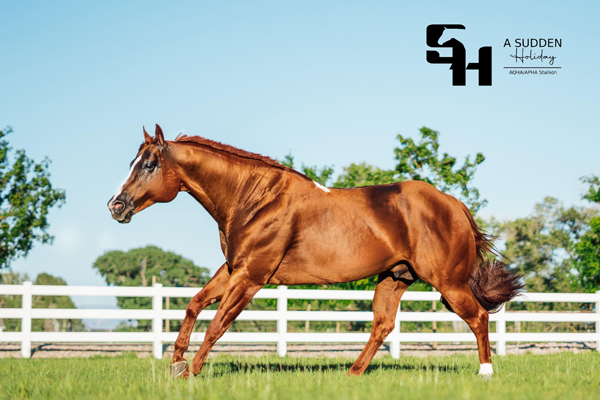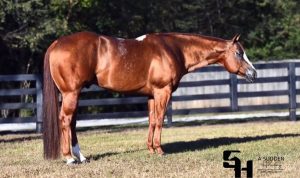Etalon Discovers New White Marking Variant W35 “Holiday” in Horses
It all started with a white spot.
A simple inquiry uncovered a genetic mystery which led to a discovery that will change the trajectory of Branson Buckalew’s breeding program.
Buckalew always knew his horses were different. His herd displayed an array of unusual and untestable white markings, including disconnected white on the lower lip and chin, markings that came off to the middle of the knee – a lot of unmistakable chrome.
“I would say maybe a little more excessive white than what you would see on a typical Quarter Horse,” said Buckalew. “That’s a lot of white to not carry a single color marker and I think one of them even had blue eyes. I thought, ‘there’s got to be something there that we just don’t know yet.’”
Etalon tested “A Sudden Holiday”, a double registered APHA/AQHA stallion by “RL Best of Sudden”, in May of 2022. His shiny sorrel coat color was typical of his genetic results: A/a e/e nd1/nd2 – One Agouti, two Red, one non-Dun Primitive Markings, but no known white variants at all. But “Hank” clearly has white markings on both sides of his withers, a belly spot, a large white blaze, and roaning across his flank and back that was not identified in his initial diagnostics report.
The Etalon team double-checked his sample for any known whites, but no known variants were detected. This was the first clue that we might be dealing with a new, yet undiscovered, white variant. Buckalew tested additional horses in his herd with comparable characteristics. Just as he suspected, their distinctive white markings were also absent from diagnostic test reports. There was clearly something here!
Given their expertise and passion for uncovering genetic puzzles, the Etalon team eagerly accepted the challenge of unraveling this mystery. Aiden McFadden, a Research Associate at Etalon, was keen to lead the investigation.
“Finding a mutation is usually like a giant puzzle, but without any edge pieces. You just don’t know where to start,” said McFadden. “You try to find patterns until something works and then you just keep testing the pattern until it’s solid.”
Currently, there are over 40 identifiable variants that contribute to white markings in horses. Determined to find the location of this new variant in the horse’s genome, McFadden started by closely examining the KIT gene sequence in about 20 horses. It wasn’t long before he found something interesting: a previously unknown genetic variant (technically termed “rs1149701677”) that might be correlated with “A Sudden Holiday’s” mysterious white patterning.
Team Etalon initially gathered a small group of 109 horses to kick off his study. The group included: 27 horses from “A Sudden Holiday’s” extended family and 82 unrelated horses consisting of Paints, Quarter Horses, Arabians, and Warmbloods. After Etalon manually examined the white spotting patterns throughout the entire group of horses, the rs1149701677 mutation continued to appear alongside the white spotting phenotype.
McFadden advanced by screening an additional set of 5,309 horses in Etalon’s database. Out of 130 horses with unexplained white markings, 123 of these horses had at least one copy of the possible mutation. The team was interested to find that this mutation affected many different breeds, not just stock horses.
To honor “A Sudden Holiday” who set off this discovery, Etalon proposed to name this new variant “Holiday” using the nomenclature W35 for the variant. This stays consistent with other KIT white spotting variants that are known as Dominant White (W).
“The W35 finding opens my stallion up to a whole new market of horses,” Bucaklew said. “I’ve been really passionate about the Paint Horse industry and so I’m glad that I had something to do with finding something new.”
APHA Executive Director Billy Smith also expressed his excitement for this discovery, stating that the APHA is committed to enhancing and diversifying the Paint Horse. “Discoveries such as the new white marker, W35, are valuable to our owners and breeders. Expanding the gene pool and registration eligibility and diversifying the population is the healthy path forward for our horses. We look forward to reviewing more details about W35 for possible APHA use when peer-review is complete,” Smith said.
It was Bucaklew’s eagerness to team up with Etalon that ultimately enabled the discovery. The collaborative effort yielded a significant breakthrough, one that could potentially revolutionize the Paint Horse industry. The discovery holds promise for expanding the APHA registry to include more horses with the white mutation.
Breeders interested in testing for the W35 gene can sign up for an account with Etalon Diagnostics here: Etalon Diagnostics













